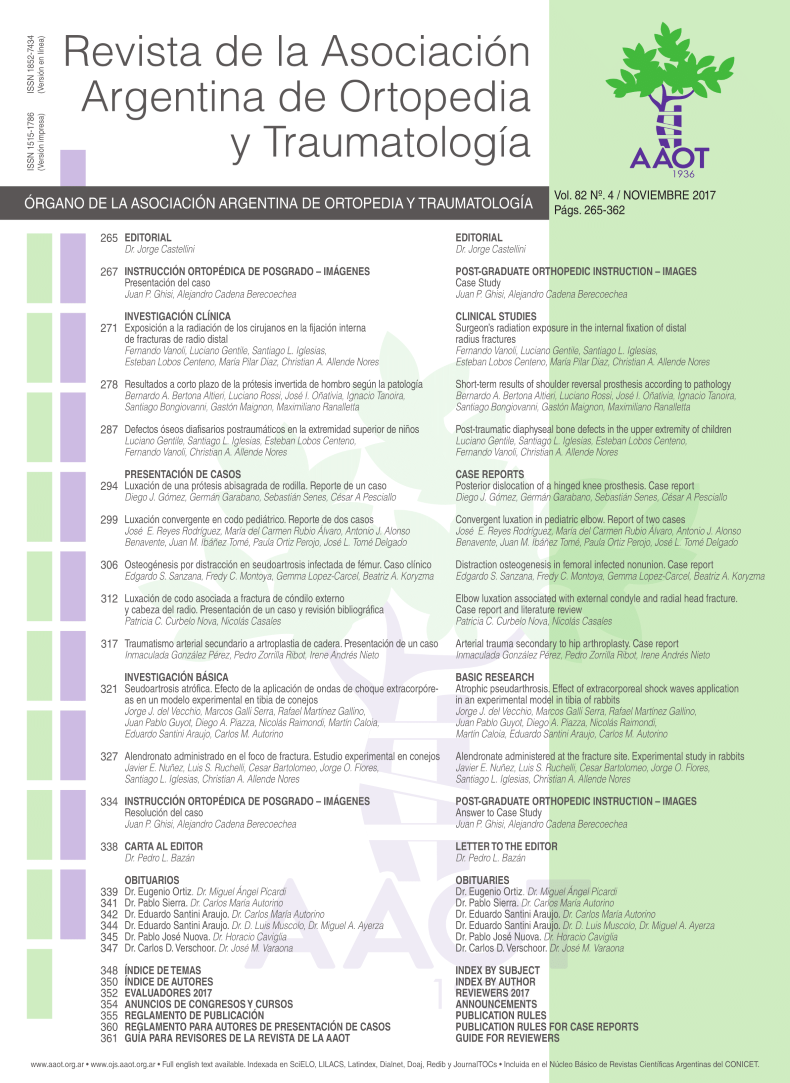Dislocation of Hinged knee prosthesis
Main Article Content
Abstract
Downloads
Metrics
Article Details

This work is licensed under a Creative Commons Attribution-NonCommercial-ShareAlike 4.0 International License.
Manuscript acceptance by the Journal implies the simultaneous non-submission to any other journal or publishing house. The RAAOT is under the Licencia Creative Commnos Atribución-NoComercial-Compartir Obras Derivadas Igual 4.0 Internacional (CC-BY-NC.SA 4.0) (http://creativecommons.org/licences/by-nc-sa/4.0/deed.es). Articles can be shared, copied, distributed, modified, altered, transformed into a derivative work, executed and publicly communicated, provided a) the authors and the original publication (Journal, Publisher and URL) are mentioned, b) they are not used for commercial purposes, c) the same terms of the license are maintained.
In the event that the manuscript is approved for its next publication, the authors retain the copyright and will assign to the journal the rights of publication, edition, reproduction, distribution, exhibition and communication at a national and international level in the different databases. data, repositories and portals.
It is hereby stated that the mentioned manuscript has not been published and that it is not being printed in any other national or foreign journal.
The authors hereby accept the necessary modifications, suggested by the reviewers, in order to adapt the manuscript to the style and publication rules of this Journal.
References
2. Manzano G, Schwarzkopf R. Posterior Dislocation of the Hinge-Post Extension in a Rotating. Case Rep Orthop. 2013;2013:4–7.
3. Schwarzkopf R, Chaudhry S, Kummer FJ, Marwin SE. Failure of the Tibial Insert in a Rotating Hinge Total Knee Arthroplasty. J Arthroplasty. 2011;26(6).
4. Wang C. J., wang henry. Case Report: Early Catastrophic Failure of Rotating Hinge Total Knee Prosthesis. J Arthroplasty. 2000;15(3):387–91.
5. Pacha-Vicente D, Malik A, Castellet-Feliu E, Nardi-Vilardaga J. Dislocation of Rotating-Hinge Knee Prostheses with Antidislocation Mechanism. J Arthroplasty. 2008;23(2):299–303.
6. Kawai A, Healey JH, Boland PJ, Athanasian EA, Jeon DG. A rotating-hinge knee replacement for malignant tumors of the femur and tibia. J Arthroplasty. 1999;14(2):187–96.
7. Chuang MY, Chang TK, Huang CH, Huang TY. Failure of the Rotating-Hinge Knee Megaprosthesis. J Arthroplasty. 2013;28(3).
8. Rand JA, Chao EY, Stauffer RN. Kinematic rotating-hinge total knee arthroplasty. J BoneJoint SurgAm. 1987;69:489–97.
9. Deehan DJ, Murray J, Birdsall PD, Holland JP, Pinder IM. The Role of the Rotating Hinge Prosthesis in the Salvage Arthroplasty Setting. J Arthroplasty. 2008;23(5):683–8.
10. Bistolfi A, Lustig S, Rosso F, Dalmasso M, Crova M, Massazza G. Results With 98 Endo-Modell Rotating Hinge Prostheses for Primary Knee Arthroplasty. Orthopedics. 2013;36(6):746–52.
11. Mayle R, Della Valle C, Biswas D, Haughom B. Failure of Rotating-hinge Total Knee Prosthesis by Disengagement of the Hinge-post Extension. Clin Orthop Relat Res. 2013;471(4):1389–92.
12. Bistolfi A, Rosso F, Crovia M, Massazza G. Endo-Modell Rotating-hinge Total Knee for Revision Total Knee Arthroplasty. Orthopedics. 2013;36(10):1299–306.

